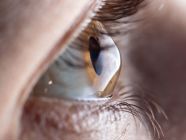Cataracts are a common condition characterized by the gradual clouding of the eye's natural lens, often age-related. If left without treatment or medical supervision, it can lead to blindness. (1)
What are Cataracts?
A cataract is not actually a collection of white fluid in the eye, as you might imagine from the common name for this disease among people. Rather, it is the gradual transformation of the transparent lens of the eye into a white or cloudy color due to the breakdown of the proteins that make up the lens and their collection together, which affects the lens’s ability to focus light on the retina and causes a gradual decrease in the clarity of vision over time. (1)
Regular eye exams, a healthy lifestyle, and timely intervention can make a big difference in maintaining your vision and overall eye health. (1)
Cataracts Symptoms
Symptoms vary from one person to another. At first, they may be mild, but as the condition progresses, they become more significant.
Symptoms include the following: (2)
- Blurred vision: It's like looking through a dirty window, and objects may appear less sharp than usual.
- Increased sensitivity to light (Photophobia): especially bright sunlight or headlights at night, which makes being in bright environments uncomfortable.
- Difficulty seeing at night (Nyctalopia): Due to decreased visibility in low-light conditions, you may have difficulty driving in low-light conditions.
- Changes in color perception: Colors may appear dull or yellow.
- Seeing halos around lights.
- Frequent changes in eyeglass or contact lens measurements.
- Unilateral double vision.
Don't let vision problems affect your life! Book your appointment today at the Ophthalmology Department at Al-Ahli Hospital for a regular comprehensive eye examination, or if you notice any sudden changes in your vision, such as double vision, flashes of light, sudden eye pain, or a sudden headache. Our specialists use advanced diagnostic techniques to evaluate and diagnose cataract and other eye conditions. (2)
What causes cataracts?
Aging is the most common cause of cataracts in the eyes. Symptoms usually begin to appear after the age of 60. But there are other causes for it other than aging, such as: genetics, exposure to eye injury, some medical conditions such as diabetes, exposure to sunlight for long periods without using sunglasses, smoking, and the use of some medications such as cortisone. (3)
How are cataracts treated?
The primary treatment for cataracts is surgical intervention, where the cloudy lens is replaced with an artificial lens, with laser or conventional surgery, which helps restore clarity of vision. This surgery is performed under local anesthesia, and usually takes 30 to 45 minutes, and the patient leaves the hospital on the same day. (1) (5)
Cataract surgery is a routine and very successful procedure, and thanks to technological advances, its success rate is approximately 97% of cases, (6) but it is necessary to follow post-operative care instructions that include: (3)
- Use prescribed eye drops.
- Attend follow-up appointments to monitor your healing and address any concerns.
- Have an eye examination every year for those older than 65, or every two years for those younger than that, according to the recommendations of the American Academy of Ophthalmology.
Can cataracts be treated without surgery?
Yes, it depends on the severity of the symptoms; If your cataract symptoms don't bother you much, you don't need surgery. There are non-surgical measures that may provide relief from symptoms and help adapt to the disease, but they do not cure cataracts. As the condition progresses, surgical intervention becomes necessary to fully restore clear vision. It is essential to consult an eye care professional to determine the treatment plan that best suits your individual needs. (4)
Among these non-surgical measures: (4)
- Eyeglasses:
In the early stages of cataracts, eyeglasses or contact lenses may help improve vision.
- Eyedrops:
Using eye drops may help relieve some of the symptoms associated with cataracts, such as dry eyes.
- Lifestyle modifications:
Quitting smoking, maintaining a balanced diet, and controlling diseases such as diabetes can help slow the progression of cataracts.
- Conditioning the surrounding environment:
By improving and brightening the lighting in your environment to make it easier to see things and do tasks. Using magnifying lenses for activities such as reading may also help reduce the effects of cataracts.
- Vitamins and supplements for Eye health
Some studies indicate that some antioxidants and nutrients, such as vitamins C and E, lutein, and zeaxanthin, may have a positive effect on eye health. However, consult a doctor before using it.
References
1. Cataracts: Signs, Symptoms & Treatment Options
2. Cataracts - Symptoms and causes - Mayo Clinic
3. What Are Cataracts? - American Academy of Ophthalmology






